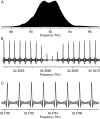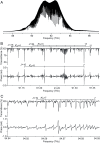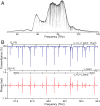Mid-infrared feed-forward dual-comb spectroscopy
- PMID: 30755528
- PMCID: PMC6397513
- DOI: 10.1073/pnas.1819082116
Mid-infrared feed-forward dual-comb spectroscopy
Abstract
Mid-infrared high-resolution spectroscopy has proven an invaluable tool for the study of the structure and dynamics of molecules in the gas phase. The advent of frequency combs advances the frontiers of precise molecular spectroscopy. Here we demonstrate, in the important 3-µm spectral region of the fundamental CH stretch in molecules, dual-comb spectroscopy with experimental coherence times between the combs that exceed half an hour. Mid-infrared Fourier transform spectroscopy using two frequency combs with self-calibration of the frequency scale, negligible contribution of the instrumental line shape to the spectral profiles, high signal-to-noise ratio, and broad spectral bandwidth opens up opportunities for precision spectroscopy of small molecules. Highly multiplexed metrology of line shapes may be envisioned.
Keywords: frequency comb; laser spectroscopy; mid-infrared; molecular spectroscopy.
Copyright © 2019 the Author(s). Published by PNAS.
Conflict of interest statement
The authors declare no conflict of interest.
Figures






References
-
- Hänsch TW. Nobel lecture: Passion for precision. Rev Mod Phys. 2006;78:1297–1309.
-
- Picqué N, Hänsch TW, Frequency comb spectroscopy. Nat Photonics, in press
-
- Baumann E, et al. Spectroscopy of the methane ν3 band with an accurate midinfrared coherent dual-comb spectrometer. Phys Rev A. 2011;84:062513.
-
- Ycas G, et al. High-coherence mid-infrared dual-comb spectroscopy spanning 2.6 to 5.2 µm. Nat Photonics. 2018;12:202–208.
Publication types
LinkOut - more resources
Full Text Sources
Other Literature Sources

